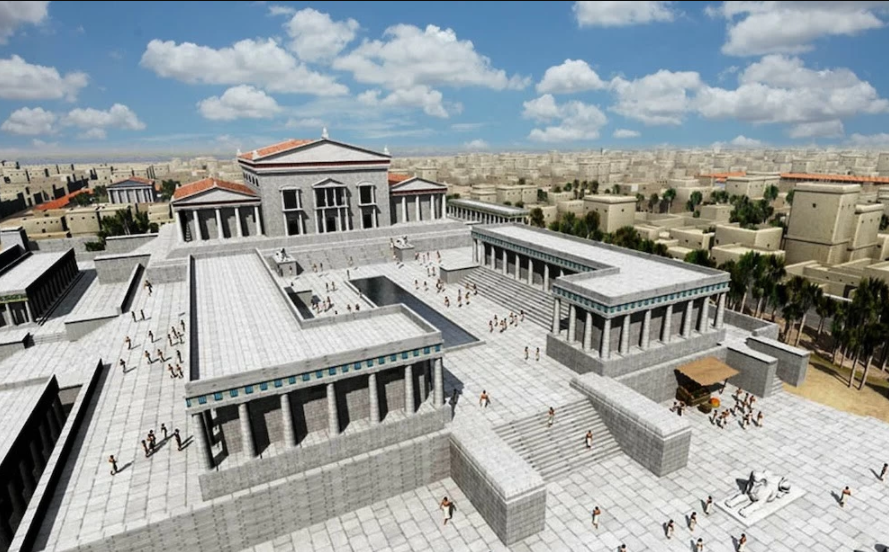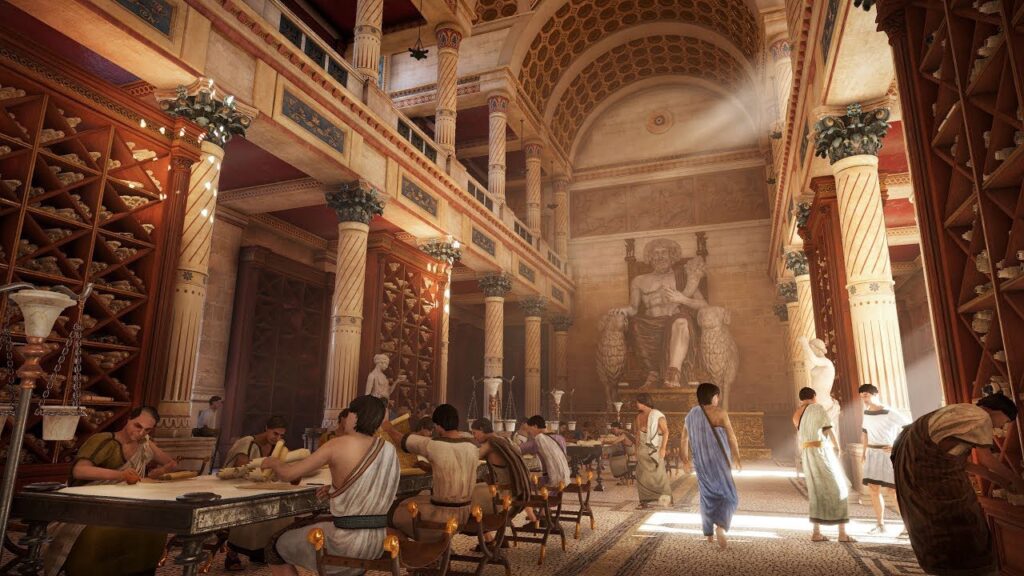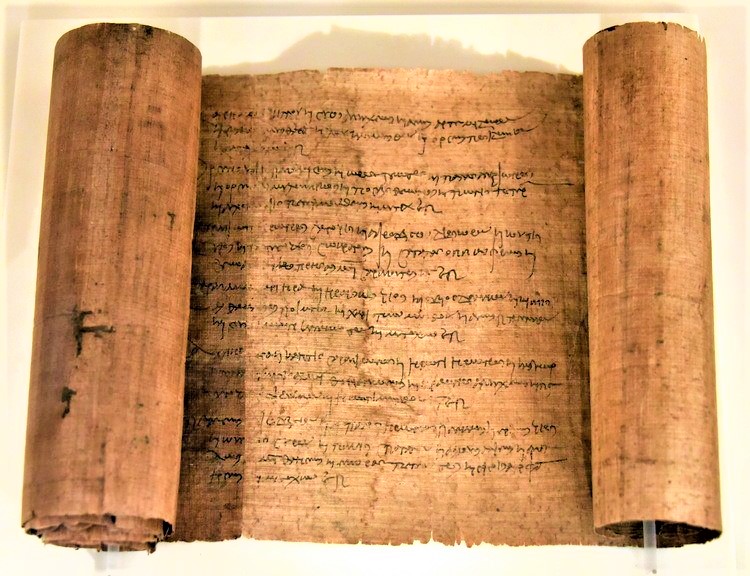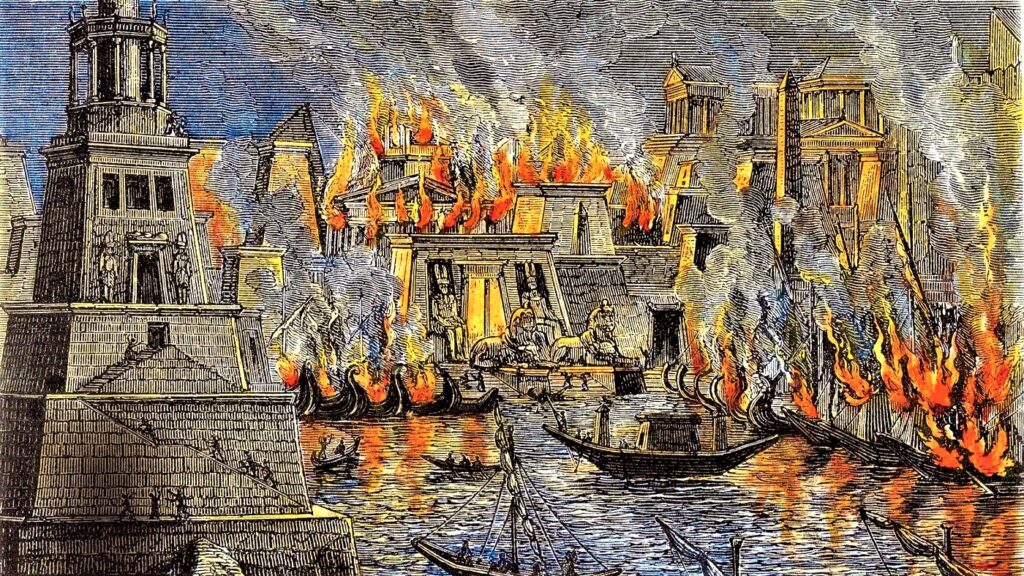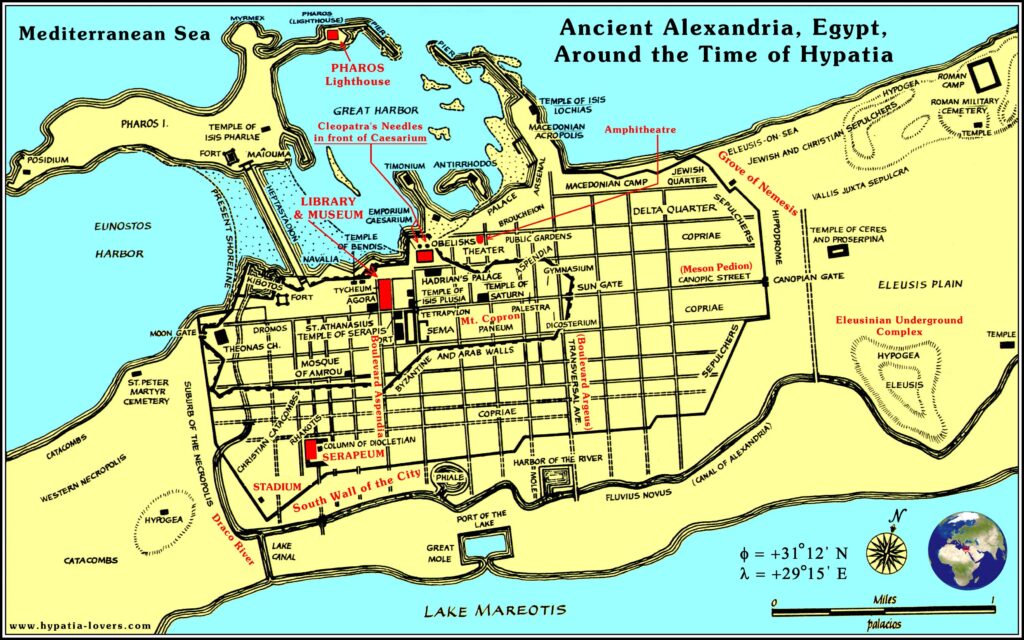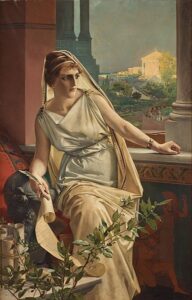The Destruction of Literary Heritage (Part 1)
TRANSCEND MEMBERS, 17 Jan 2022
Prof Hoosen Vawda – TRANSCEND Media Service
The Great Library of Alexandria in Antiquity
It is appropriate to begin in ancient history[1] to highlight how libraries were destroyed for political and territorial gains by stronger forces oppressing the weaker ones, throughout history.
The famous library of Alexandria, as artistically painted, by artist O.Von Corven’s interpretation of the Library, based on archaeological evidence, on the southern Mediterranean coast, in present day Egypt, was the mythic repository of ancient knowledge. It was a library which wanted to have a copy of every book ever written. Researchers sought out copies of nearly all classical antiquity works, copied, stored, and consulted. The library itself was founded in the 3rd century BCE and destroyed sometime in the late Roman era. It is estimated to house a million texts, which were catalogued and copied within the Great Library or its daughter library or warehouses. Over the centuries, antiquity scholars debated whether this library really existed, and if it did, what it contained, and when it perished? [2] Scholars working at the Library were paid by Pharaoh, had free meals, accommodation and servants so they were able to focus only on research studied at the Library of Alexandria. Many important scholars are reported to have studied at Library of Alexandria amongst them Archimedes[3] and Euclid, the father of geometry.
Alexandria, a city in modern day Egypt, was founded by Alexander the Great [4]in 331 BC. (356-323 BCE), when the library project began, is the reason for the Great Library’s existence. He famously built his massive empire in just over a decade, from his succession to the Macedonian throne, to his untimely death in 323 BCE. However, the political stability of his empire died with him. But what lived on was a cultural fusion, a mixture of eastern and western philosophy, ideology, and culture. The city of Alexandria in the Ptolemaic Dynasty was Alexander’s lasting legacy was rooted in dozens of cities that he founded, including around fifteen cities named Alexandria. None was more significant than Alexandria by Egypt, established in 330 BCE. [5]Alexandria was a Greek enclave located west of the Nile Delta near the fishing village of Rhakotis. It was a glittering and golden new city, meant to strike awe in visitors with its fabulous wealth. Ptolemaic Egypt became the most powerful kingdom born of Alexander’s empire, founded by the great king’s friend and general, Ptolemy I Soter (367 BC – 282 BC). After the death of Alexander his general Ptolemy I Soter[6], gained power over Egypt. Alexandria became an international hub for a trade between East and West. It was one of the largest cities of antiquity, only Rome was bigger. In order to safely lead ships in to the harbour and to show off their wealth, Ptolemaic rulers built the Lighthouse of Alexandria. One of the tallest man-made buildings of Ancient world and considered one of the Seven wonders of the world, at the time. Furthermore, Egypt was also a leading manufacturer of papyrus. Predecessor of modern-day paper. Papyrus was made from papyrus plant, which is growing around the river Nile.
The Library of Alexandria was part of Musaeum, a science research center dedicated to knowledge. It was built during the reign of Ptolemy II Philadelphus, 284–246 BC.
Ptolemaic rulers of Egypt fostered progress and knowledge collection. They gave scholarships to scientists, philosophers and poets to come and live in Alexandria.
In exchange rulers were getting advice on how to rule their vast country. The Library of Alexandria was eager to maintain position of the greatest source of knowledge. Supported financially by Ptolemaic rulers of Egypt librarians collected every book available.
They were buying books. They were transcribing books. It was said books were transcribed with a such accuracy it was impossible to notice whether they returned originals or a copy.
Each time a ship arrived to the harbor, the librarians would search the ship and take all the books. The legend states that Ptolemy III asked Athenians to borrow original manuscripts by Sophocles, Aeschylus and Euripides. Athenians demanded 500 kg of gold as a guarantee to get the scrolls back. The tomes were lent to the Librarians who copied manuscripts, kept originals and give to Athenians copies saying to them they can keep the gold.
At its height Library of Alexandria housed 400.000 scrolls which would be an equivalent of 100.000 books. At certain point in history, an annex to main library had to be established in the Serapeum, a temple of the god Serapis[7], a god whose cult was developed by Ptolemy I at Memphis as a combination of Apis and Osiris, to unite Greeks and Egyptians in a common worship, in order to be able to house all the books.
Archimedes, famous for his Archimedes principle, a law of displacement, visited Library of Alexandria. It is said Archimedes noticed the need of nearby farmers to deliver water from Nile to higher plateaus. He solved a problem by inventing Archimedes screw. An invention still used today. Archimedes friend Eratosthenes was head of Library of Alexandria. Like Archimedes Eratosthenes was considered a genius. Eratosthenes was nicknamed a Father of Geography because he accurately calculated circumference of the Earth and distance between Earth and Sun, in 240 BC.
Eratosthenes calculated the planet to be 24,650 miles around which is almost the actual distance of 24,900, using 21st century technology. He predicted a leap year of 366 days every fourth year and started using parallels and meridians. Additionally, he invented a mathematical method for discovery of prime numbers, which is called a Sieve of Eratosthenes, who had access to the manuscripts, housed in Library of Alexandria, which helped him in his research.
One theory disputes the widely accepted opinion that the Library of Alexandria was destroyed by Julius Caesar and Romans who were involved in civil war in Egypt in 48 BC.
Caesar set fire to the ships in nearby harbor, but unfortunately fire spread into the library. However most important scrolls were saved. However, historians propose that the Library of Alexandria declined in its importance gradually over the centuries.
Decline of the Library of Alexandria corresponds with the decline of Egypt. Ptolemaic reign weakened over the centuries and their kingdom was eventually usurped by the mighty Roman empire. During Roman reign Library received much less funding which lead to decline of research and number of scrolls. In 270 AD Alexandria revolted against Rome which lead to imperial counterattack and destruction of the Library. However, it’s twin sister Library at Serapeum survived till 391 when it was demolished on orders from Christian Bishop Theophilius of Alexandria[8]. Books, which survived were completely destroyed in 7th century by Muslim rulers of Egypt. These acts of burning of books, based on religious doctrines of the Abrahamic faiths is a serous indictment on how religion has played a significant role in the total annihilation of existing knowledge, based on respective religious sectarianism.
The arsonist destruction of Library of Alexandria meant a huge loss of knowledge and significantly slowed down progress of humanity. Librarians knew the Sun and not the Earth was center of our solar system. They knew Earth was round. It took another thousand years and geniuses such as Galileo and courageous explorers such as Columbus and Magellan to discover the truth again. The destruction of Library of Alexandria symbolises loss of knowledge due to political or religious reasons.
Designed by Alexander’s architect Dinocrates, Alexandria featured monumental architecture, a great harbor, the famous nd the Museum and Great Library, which served as the intellectual capital of the Hellenistic world. As a cosmopolis or universal polis, Alexandria was Greek in language, culture, and political orientation but global in population. Greeks co-existed alongside Egyptians, Persians, Jews, Indians, and eventually Romans.
Regarding the foundation of the Museum, the first textual evidence for the Great Library comes from the 2nd century BCE Letter of Aristeas. Some historians deem the letter is a source of apocryphal propaganda. Surviving only in part and in later sources, the letter was purportedly written by an official at the court of Ptolemy II Philadelphus, it documents both the library’s formation and one of the most notable Greek translations to have taken place in that foundation, the Septuagint, the Greek Old Testament, a translation of the Hebrew Torah, the first five books of the Old Testament.
Later authors writing in the Roman era, Strabo and Plutarch, place the library’s origin during the reign of Ptolemy I. Plutarch wrote of the exiled Athenian Demetrius. He proposed a Museum, or temple of the Muses, and accompanying library at the court of Ptolemy I in Alexandria. Ptolemy I wanted to codify Alexander the Great’s personal diaries and histories. Demetrius’ plan offered a means to this end. By the end of his reign, Ptolemy reportedly collected upwards of 50,000 texts that cluttered the rooms of his palace and formed the core of Demetrius’ proposed repository.
Ptolemy III Eugertes (280-222 BCE) continued work on the Great Library, vastly expanding the collections. He reportedly sent buyers across the Mediterranean to search bookstalls, aiming to acquire copies of the entire canon of classical works. By his decree, ships ported in Alexandria were searched for scrolls to be copied or stored at the Great Library. Warehouses at the harbor provided means to return works or for distribution elsewhere.
Personal libraries were common in the ancient world, but public libraries, particularly at the purported scale of Alexandria’s, were an innovation. Something akin to a university, the Museum and Library at Alexandria served as a home for books and scholars. The Greek geographer, in the 2nd century CE, described the Museum and Library complex as “part of the palaces, possessing a peripatos as covered walkway and extra circular platforms with benches for discussion and large oikos house…”
As a reference library, Alexandria was reportedly unparalleled. King Eumenes II of Pergamum (197-159 BCE), a rival kingdom, competed to accumulate a collection of 200,000 texts, but Alexandria dwarfed his library. Estimates for the collection size of the Great Library of the Ptolemies vary enormously, from 40,000 scrolls to 1,000,000 texts. It is to be noted that scrolls, rather than books, were the typical format for texts. Multiple papyrus rolls could comprise one book or volume, which may account for this statistical disparity. Alexandria’s greatest librarian was the poet Callimachus of Cyrene [9](310-240 BCE). For instance, he innovated a cataloging system, comprising 120 separate volumes, documenting eight categories of texts held in Alexandria. [10]The catalogues, what Callimachus called the Pinakes, or Lists, included biographical and bibliographical detail on each source.
His work was thought to include references to all known works of classical literature to his day. Additionally, he organised the library’s holdings by category, including dramatists, rhetoricians, orators, historians, philosophers, legislators, poets, and miscellaneous works. The physical texts were organized in the library, first by category and then alphabetically, by each title’s first letter.
The Library Collection itself is worthy of detailed description. Natural philosophers, engineers, mathematicians, and others would have stayed at the library when working in Alexandria. More than an attraction for bibliophiles, the library was an active community of scholars and an environment conducive to engaging in higher cortical functions of the humanoid brain. However, one academic, Timon of Philus[11], rejected from a residency at the library, bitterly addressed the community of scholars as “endowed scribblers.” In addition to the classical works of Hesiod, Homer, Euripe Euripedes, Aeschylus, Plato, and Aristotle, contemporary poets and authors worked at Alexandria, including Apollonius of Rhodes and Theocritus of Syracuse. The Ptolemies were patrons of the sciences, particularly favoring the works of mathematicians and astronomers such as Archimedes, Euclid, Eratosthenes, and Aristarchus of Samos.
It is to be noted that according to ancient historians there were many destructions of the Great Library which it suffered as a series of accidents or deliberate phases of destruction. It is impossible to reconstruct what texts are lost and when it happened. Portions of the Great Library, the daughter Library at the Serapeum, or scrolls held at the warehouse may have suffered destruction during different periods. Later, Roman authors refer to works of the playwright Meander, Varro’s Antiquities, and portions of Livy’s History of Rome that may have been consulted in Alexandria and are lost today. However, the first destruction is attributed to Julius Caesar as an arsonist for the first fire at the library. Following his victory at the battle of Pharsalus in 48 BCE, Julius Caesar pursued his defeated rival, Pompeius Magnus, to Egypt. Caesar arrived in Alexandria as a civil war raged between young king Ptolemy XIII (62-47 BCE) and his older sister Cleopatra VII (69-30 BCE).[12] While in Egypt, Ptolemy XIII’s forces besieged Caesar and his troops at the harbor in Alexandria. Caesar instructed his men to set fire to the Ptolemy XIII’s fleet. But the summer winds spread the flames from the port into the warehouses and perhaps even into the city.
Plutarch tells us in the 2nd century CE of the burning of a portion of the library’s holdings, likely dock-side warehouses but possibly the Great Library itself. Historians question whether this fire, if it occurred, was accidental at all, or a deliberate and pointed act by Caesar to eliminate the library, as a means of punishment of the defeated who dared to counteract the might Caesar. However, the Great Library in the late Roman Empire was subjected to several other episodes of the destruction of the Museum and Library are hypothesised in Late Antiquity. From the late Roman emperors to the 7th century Caliph Omar, both the city of Alexandria and the library could prove dangerous. As the intellectual capital of Egypt, Alexandria boasted a well-informed and wealthy populace. As Rome shifted from a pagan to a Christian empire, Alexandria became even more dangerous as a source of knowledge that contradicted the new faith and tenets of Christianity. The Christian Church, at the time, felt extremely threatened and contributed further to the progressive destruction of the Great Library, which was considered the source of anti-religious knowledge ,which could undermine the unique authority of the Holy Church.
During the third century, the Roman Empire became torn apart by internal and external pressures. The third-century chaos saw the empire’s division into as many as five parts. The empire only became mended with the reign of Diocletian (284-305 CE). Both Diocletian and his predecessor Aurelian (270-275 CE) oversaw conflagration and revolt in Alexandria. This may have resulted in losses at the Great Library.
In the reign of Emperor Theodosius I (378-395 CE), Rome entered a new era, of dominance of the power of the Church. Late Antiquity, Christianity had taken firm root in what remained of the empire by the fourth century leading to the further spread of Christianity.. Moreover, Christianity left the numerous classical or “pagan” Greek philosophies relegated to a shrinking population of intellectuals. Paganism as a living religion became outlawed in 391 CE. In fact, religious paganism became affiliated with simple country folk, the pagani (people of the pagus). The last great pagan philosophers, including many Neoplatonists, maintained their beliefs in the shadows. The new Christian Empire deemed learning of the classical past as less valuable, and this was the most important factor in the generation of new knowledge, resulting in the academic and intellectual importance of the Great Library fading away.
In an age of Christian victory, the Library became a repository of knowledge secondary to the more critical factors of faith. In 391 CE, a riot in Alexandria centered on the Temple of Serapis, the Serapeum, may have led to the conflagration of both the daughter Library and the Great Library itself. One of Alexandria’s Neoplatonist philosophers Hypatia is often associated with the library and its destruction. However, her death in 415 CE occurred decades after the assumed final destruction. [13]
Presently, peri-Alexandrian seas house many sunken secrets of ancient Egypt which are are routinely discovered in the Mediterranean Sea, by divers in relatively shallow waters, not needing any specialized diving equivalent or salvage vessels as was used for the discovery of the ill-fated Titanic by Dr Robert Ballard in 1895[14]. The Mediterranean shoreline area is an active site of diving and marine search expeditions which continue to reveal statues, sculptures, and architectural columns and blocks from the old city and harbor. In fact in using modern technology, divers have recently uncovered and retrieved Roman coins from antiquity
The Bottom Line is that while in 2002 the construction of a new Library of Alexandria is a “spiritual successor” of the ancient Great Library at Alexandria, the extensive volumes of books and manuscripts could never be replaced, nor could the vast knowledge contained therein is lost forever. While destroyed by individuals in the name of acquisition of power, personal egos, perceived threat to religions emerging at the time, the Great Library of ancient Alexandria remains a lost intellectual wonder of the world and inspiration for new generations.[15] The cowardly act of active destruction by arson, of supposed great generals like Julius Caesar, is a serious indictment on humanity and sad to note that such sentiments still persist in recent times and even today in the midst of civil wars, changes in regimes and revengeful attacks on diffent ethnic as well as religious sectors of humanity. These aspects will be presented in Part 2 of this
References:
[1] Lionel Casson, Libraries in the Ancient World (Yale University Press, 2001).
[2] https://historyofyesterday.com/library-of-alexandria-13c1e5c98a18#:~:text=Library%20of%20Alexandria%20%E2%80%94%20myths%20and%20facts
[3] https://en.wikipedia.org/wiki/Archimedes%27_screw
[4] https://www.britannica.com/biography/Alexander-the-Great
[5] Roger S. Bagnall, “Alexandria: Library of Dreams,” Proceedings of the American Philosophical Society, Vol. 146, No. 4 (Dec., 2002), pp. 348-362.
[6] https://en.wikipedia.org/wiki/Ptolemy_I_Soter
[7] https://en.wikipedia.org/wiki/Serapis
[8] https://orthodoxwiki.org/Theophilus_of_Alexandria
[9] https://en.wikipedia.org/wiki/Callimachus
[10] S. Johnstone, “A New History of Libraries and Books in the Hellenistic Period,” Classical Antiquity, Volume 33 (October 2014): 347-393
[11] https://en.wikipedia.org/wiki/Timon_of_Phlius
[12] Andrew Erskine, “Culture and Power in Ptolemaic Egypt: The Museum and Library of Alexandria,” Greece & Rome, Vol. 42, No. 1 (Apr., 1995), pp. 38-48.
[13] S. Johnstone, “A New History of Libraries and Books in the Hellenistic Period,” Classical Antiquity, Volume 33 (October 2014): 347-393
[14] https://www.youtube.com/watch?v=5Q3eA6wYil4
[15] Justin Pollard and Howard Reid, The Rise and Fall of Alexandria: Birthplace of the Modern World (Penguin, 2006)
______________________________________________
 Professor G. Hoosen M. Vawda (Bsc; MBChB; PhD.Wits) is a member of the TRANSCEND Network for Peace Development Environment.
Professor G. Hoosen M. Vawda (Bsc; MBChB; PhD.Wits) is a member of the TRANSCEND Network for Peace Development Environment.
Director: Glastonbury Medical Research Centre; Community Health and Indigent Programme Services; Body Donor Foundation SA.
Principal Investigator: Multinational Clinical Trials
Consultant: Medical and General Research Ethics; Internal Medicine and Clinical Psychiatry:UKZN, Nelson R. Mandela School of Medicine
Executive Member: Inter Religious Council KZN SA
Public Liaison: Medical Misadventures
Activism: Justice for All
Email: vawda@ukzn.ac.za
Tags: Books, History, Literacy, Literature
This article originally appeared on Transcend Media Service (TMS) on 17 Jan 2022.
Anticopyright: Editorials and articles originated on TMS may be freely reprinted, disseminated, translated and used as background material, provided an acknowledgement and link to the source, TMS: The Destruction of Literary Heritage (Part 1), is included. Thank you.
If you enjoyed this article, please donate to TMS to join the growing list of TMS Supporters.

This work is licensed under a CC BY-NC 4.0 License.
